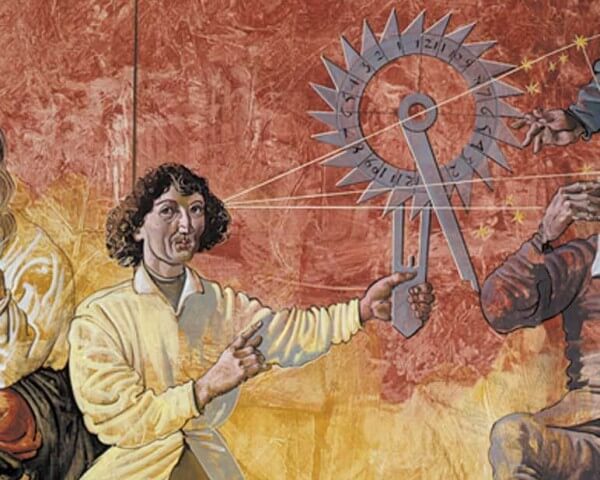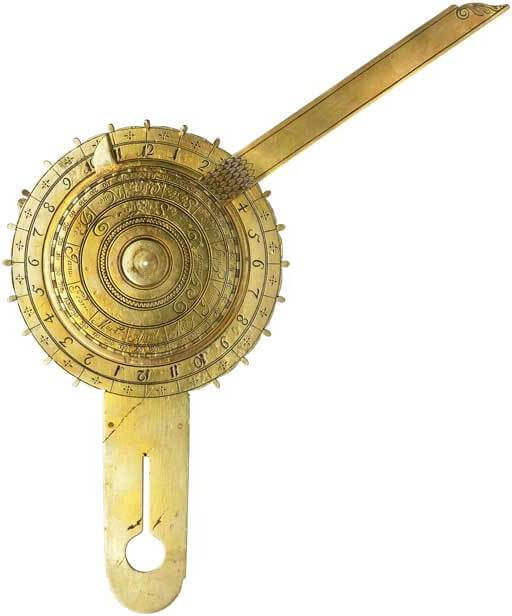The nocturnal is basically an astrolabe for night-time use. The astrolabe was invented in antiquity, probably by Hipparchus in the 2nd century BC, and described three centuries later by Ptolemy. It was a sophisticated instrument which represented the movement of the stars in the heavens on a flat surface. Although little used by the Greek astronomers, it was widely adopted by Muslim astronomers from the 12th century onwards. A simplified version intended for navigating the high seas made its appearance in Europe in the 14th century. This nautical astrolabe was first used only to calculate latitude by using the Pole Star as a reference point, visible in the night sky in the northern hemisphere.
It was not until the 15th century, around 1485, that the introduction of practical declination tables for the sun made the mariner’s astrolabe usable during the day anywhere around the globe. This progress is due to the Portuguese, particularly to Martin de Behaim, King John II’s astronomer, who expanded its use among navigators. Later, navigation was made easier by inventions such as the Davis quadrant (backstaff) in around 1595, or Hadley’s octant (1731) –both predecessors of the modern sextant – and above all the marine chronometer, which resolved the problem of longitude at sea and was first tested in 1736 by its inventor John Harrison.
The Pole Star as a reference point
While the history of the astrolabe remains well documented, it is not known when the nocturnal first appeared or by whom it was invented. It was most likely used for numerous purposes at various times in history, but it is essentially remembered for its role in the progress of navigation. In fact, the first mariner’s astrolabes were nocturnals. They were comprised of graduated discs, a revolving arm or azimuth reading device, and a handle with which to hold them vertical. To measure latitude, the 0° mark on the graduated ring was aligned with the horizon; then, by pointing the azimuth reading device at the Pole Star, the value for the angle of elevation could be obtained.
This function alone would suffice for defining a mariner’s nocturnal, but sailors also used it to calculate local time at night. In this case, the instrument possessed two rings centred on a clevis pin: one graduated in days and months and the other in hours. The time was obtained by placing the graduation representing midnight on the observation date and sighting the Pole Star through the central hole; the azimuth reading device was then aligned with the two pointer stars in Ursa Major, which acted like the large hand of a clock dial. This measurement was made possible because in the northern hemisphere the stars appear to revolve around the Pole Star and complete an entire revolution in approximately 24 hours (23 hr 56 min). With the appropriate indicating device, Kochab and Pherkad, the two bright stars in Ursa Minor, could be used instead of the Ursa Major pointer stars. A nocturnal could also be used to calculate high-tide times in ports in relationship to the passage of the moon over the meridian (line running north-south in the sky at its zenith), providing the age of the moon (number of days since the new moon) is known.

Limited precision
The precision of a nocturnal could be affected by various factors, starting with the four minutes of difference between our standard 24-hour day and sidereal time (23 hr 56 min). It was therefore necessary to adjust the nocturnal regularly in order to take this discrepancy into account. However, the principal source of error came from the difficulty in aligning the azimuth reading device with the pointer stars in rough seas. A second major source of error came from the imprecise divisions on the graduated scales, due to the disc size limited to the diameter traced by the stars in Ursa Major or Ursa Minor. Finally, one does not usually take into account that at that time the Pole Star was shifted 2 to 2.5 degrees off from the North Celestial Pole. Nevertheless, the nocturnal was a valued instrument in Northern latitudes. Nocturnals designed for Southern latitudes using the Southern Cross as a point of reference may have existed, but sources do not agree on this point.
(1) One side of this instrument, placed horizontally, was used during the day as a sundial.
The other side, held vertically, is the nocturlabe. It was used to read the time at night by observing the position of the stars.
This nocturlabe is from a private collection on loan to the Musée de l’Horlogerie et du Décolletage in Cluses (France).
(2) The Pole Star is sighted through the central hole and the moveable index aligned with the last two stars of Ursa Major. The time is then read off the graduated scale in accordance with the month.














